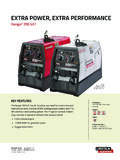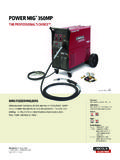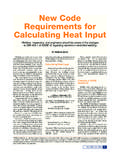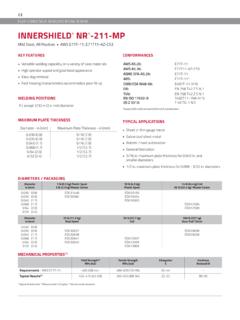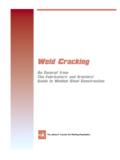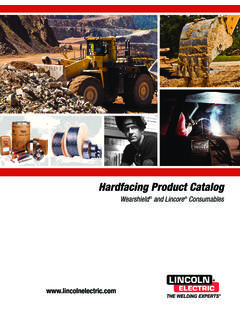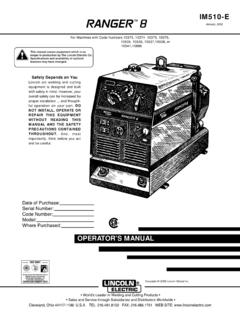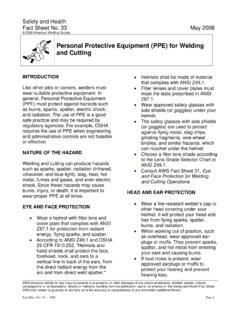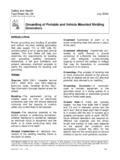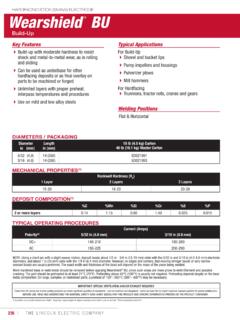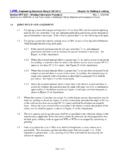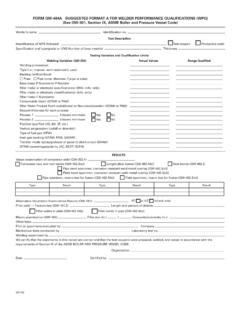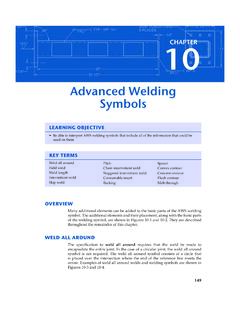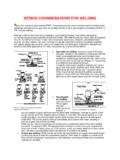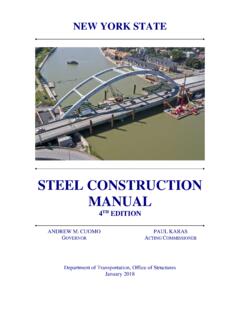Transcription of Filler Metals - Lincoln Electric
1 Filler Metals Selection Guide 1. The serviceability of a product or structure utilizing specified properties of the steel. Matching Filler these suggested consumables is and must be metal is typically required for complete joint the sole responsibility of the builder/user. Many penetration groove welds in tension. However, factors must be taken into consideration when a fillet welds loaded in shear seldom require Filler metal is selected for a specific application. matching Filler metal. Depending on the type of These factors include, but are not limited to, the weld joint and loading, lower Filler metal strengths type of steel, type of weld , loading on the welded may be acceptable or desirable for specific designs.
2 Joint, applicable codes, level of preheat, level of Also, codes, specifications, or contract documents restraint, position of welding, condition of the may require specific mechanical properties that steel, and service conditions. This guide provides these recommendations do not meet. In those matching strength Filler metal options see cases, electrode selection should be limited to discussion about undermatching below. The those products that meet the specific application primary focus of these suggestions is based upon requirements. Suggested electrodes in this Selection the yield and tensile strength properties of the Guide include those that have deposit weld metal weld deposit as compared to the base metal yield with different levels of diffusible hydrogen.
3 High and tensile strength properties. These suggested levels of hydrogen can cause weld metal and base products may not meet all code or application metal cracking. The permissible level of hydrogen requirements. Suggested Filler Metals may not in a weld deposit is dependent on many factors, always meet Charpy V-Notch (CVN) application including preheat and interpass temperatures requirements reference comments below intended to be used. The user of this information on CVN's. must make certain that, for the suggested electrode that is selected, the preheat and interpass Reference is made to ASTM and API specifications temperatures will be proper for the application.
4 And classifications and the requisite properties Suggested Filler Metals in this Selection Guide do specified in those documents. These specifications not always consider notch toughness (example are subject to change, and the user should consult Charpy V-Notch properties) requirements. Not all the latest version of these documents to ensure welding products are required to have minimum that these descriptions are up-to-date. These specified levels of notch toughness. If code, Filler metal suggestions match the base metal specifications, or contract documents require properties; that is, the yield and tensile strength notch toughness, electrode selection should be are expected to meet or exceed the minimum limited to those products that meet the specific application requirements.
5 CUSTOMER ASSISTANCE POLICY. he business of The Lincoln Electric Company is manufacturing and selling high quality welding equipment, consumables, and cutting equipment. Our challenge is to meet the needs of our customers and to exceed their T. expectations. On occasion, purchasers may ask Lincoln Electric for advice or information about their use of our products. We respond to our customers based on the best information in our possession at that time. Lincoln Electric is not in a position to warrant or guarantee such advice, and assumes no liability, with respect to such information or advice. We expressly disclaim any warranty of any kind, including any warranty of fitness for any customer's particular purpose, with respect to such information or advice.
6 As a matter of practical consideration, we also cannot assume any responsibility for updating or correcting any such information or advice once it has been given, nor does the provision of information or advice create, expand or alter any warranty with respect to the sale of our products.. Lincoln Electric is a responsive manufacturer, but the selection and use of specific products sold by Lincoln Electric is solely within the control of, and remains the sole responsibility of the customer. Many variables beyond the control of Lincoln Electric affect the results obtained in applying these types of fabrication methods and service requirements.
7 Subject to Change This information is accurate to the best of our knowledge at the time of printing. Please refer to for any updated information. 2. Filler Metals Selection Guide This guide lists recommended Lincoln Electric Table Of Contents matching strength Manual Stick (SMAW), MIG. (GMAW), Submerged Arc (SAW), Self-Shielded Technical Supporting Notes, Codes.. 4-5. and Gas-Shielded Flux-Cored (FCAW-S, FCAW-G). electrodes for ASTM, API and ABS classified steels. American Society of Testing and Also included is general information on each Materials (ASTM) Specifications .. 6-29. classification such as tensile strength, yield strength and steel chemistry.
8 American Petroleum Institute (API) Specifications.. 30-35. American Bureau of Shipping (ABS) Specifications.. See ASTM A131. 3. Technical Supporting Notes, Codes Due to space consideration, technical supporting notes are listed here. Each is tied to a code used in the body of the tables which comprise the remainder of this book. The notes and codes are listed below and may be used to reference additional information regarding recommended Lincoln Electric consumables for each application. Please be sure to use the notes as an aid in selecting Lincoln Electric consumables. SMAW (9) Use Jet-LH-8018-C1 or Excalibur 7018-1 when (1) Any E70X8 electrode may be used.
9 Excalibur high impact properties (CVN) down to -75 F. 7018, Jet-LH 78, Excalibur 7018-1, and Jetweld are required. LH-75 are preferred over Jetweld LH-70 for most pipe and out-of-position welding. (28) Use of Shield-Arc 90 should be limited to Jetweld LH-3800 can be used in place of 3/8 in. maximum wall thickness. E7018's for flat and horizontal fillet , lap, and flat butt welds. SAW. (10) For single pass applications, any flux/wire (2) Almost any E60XX or E70XX electrodes can combination meeting an AWS F7AX. be used. First, select electrode based on classification per AWS specification the joint requirements. If code, specifications, may be used.
10 Typically, for single pass or contract documents require notch applications, active fluxes such as 760, 761, toughness, electrode selection should be 780 and 781 are recommended. 860, 865, 960. limited to those that meet the specific and 980 fluxes may also be suitable for single application requirements. pass applications. The following flux/wire combinatins are classified under and (3) Almost any E70XX electrode can be used. are recommended: 760/L-50, 760/L-61, 761/. First, select electrode based on the joint L-60, 761/L-61, 780/L-60, 781/L-50, 781/L-60, requirements. If code, specifications, 781/L-61, 860/L-50, 860/L-61, 865/L-50, 865/.
